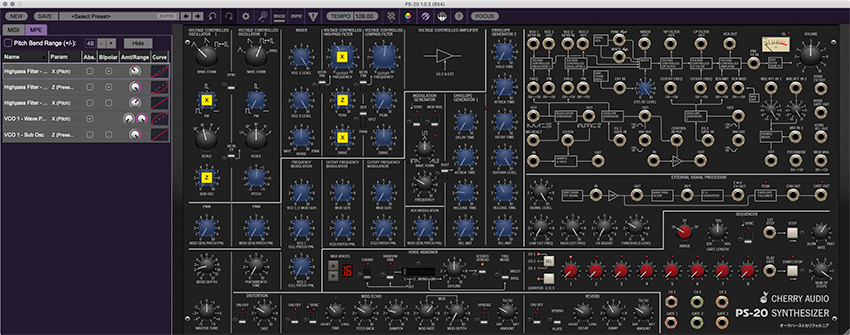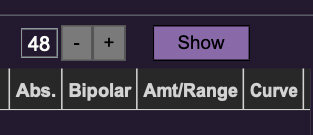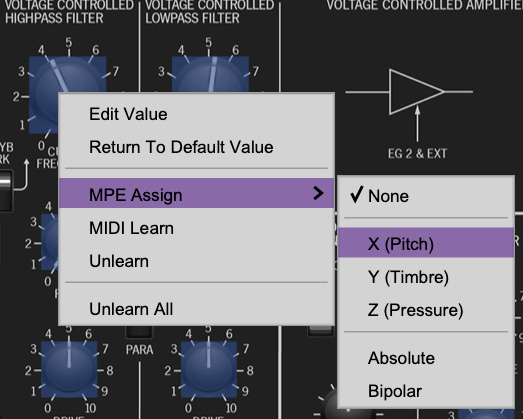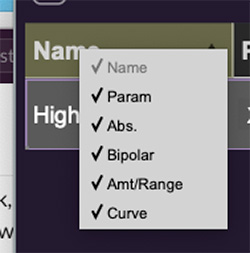
PS-20 supports MPE, short for "MIDI Polyphonic Expression." It's a specialized MIDI protocol enabling multidimensional controllers for controlling multiple parameters of individual notes. MPE specifies the MIDI messages used for three dimensions of control, regardless of how a particular controller physically expresses them. MIDI channel 1 is used as a master channel for global pitch bend, aftertouch, etc.; MPE utilizes MIDI channels 2-15 for the remaining controller data.
To enable MPE mode, MPE needs to be be enabled in the Settings menu. Click the Settings gear icon in the top purple toolbar, then the Interface tab, then check the Enable MPE mode box. Exit out of the Settings window and click the MPE icon in the top tool bar.

MPE Control Tab

Do not enable MPE mode if you're not using an appropriate MPE controller, as PS-20 won't play correctly with a standard USB MIDI controller while in MPE mode.
Pitch Bend check box and Range controls- At the top of the tab is a checkbox which enables pitch bend; to its right is the pitch bend range control. Its default setting is 48 semitones (four octaves). For best results you will need to match this number with your MPE controller's pitch bend setting (most MPE controllers default to 48 semitones).
IMPORTANT: If MPE mode is enabled, you must use a MPE controller set to ”Lower Mode” to achieve full MIDI control. If you're using a non-MPE MIDI Controller, or the QWERTY Musical Typing keyboard, only one mono voice will trigger.

Show/Hide Button - Clicking the Show button in the MPE panel highlights all of the available MPE mappable control sliders for the PS-20 with blue overlays. Click the Hide button to hide them.

To map a control slider, right-click or [OPTION]+click (Windows) / [CONT]+click (Mac) the slider you wish to map. This reveals the controller mapping menu. Select MPE Assign.
Options are:
X (Pitch)
Y (Timbre)
Z (Pressure)
Note: Some MPE controllers such as the Roli Seaboard may have as many as five dimensions of expression. PS-20 utilizes the three standard dimensions: Pitch, Channel Pressure, and Timbre. Also, not all MPE controllers are equipped with a master/global pitch bender.
Once mapped, the Name and Parameter will be visible in the MPE tab. A yellow square indicator (X,Y,Z) also appears atop each of the mapped controls.
MPE Tab Columns

Right-clicking any of the column headers opens a popup menu allowing each header to be shown or hidden.
Name- Displays the name of the parameter being controlled.
Parameter- Displays and allows selection of the three controller types: X (Pitch), Y (Timbre), and Z (Pressure).
Absolute- Sets the Amt/Range of the controller to absolute or relative control.
Bipolar- Enables bipolar controller, i.e. the ability to add and subtract the parameter amount, as opposed to positive only.
Amount/Range- Sets the intensity of control range. If set to Absolute mode, two knobs appear for min/max settings.
Curve- These allow the customization of how controller data affect the movement of PS-20's onscreen controls, ranging from exponential to linear to logarithmic curves.
MPE Tab Column Configuration Right-Click Menus

Right-clicking anywhere in the top row (Name, Type, Value, etc.) displays the column configuration menu.
Auto-size This Column- Automatically resizes so that all text in this column is visible.
Auto-size All Columns- Automatically resizes all columns simultaneously so that all text visible.
Column View Filters- Clicking any of these will hide or show the respective columns.
MPE Tab Parameters Right-Click

Right-clicking on an assigned parameter opens the menu above.
Remove- Deletes the selected MPE controller parameter.
Remove All- Deletes all MPE controller assignments for the patch. PS-20 displays a warning dialog prior to deletion in order to thwart potential disasters.
MPE Mappable Parameters
Below are all mappable PS-20 MPE parameters. Note that only polyphonic parameters (i.e. parameters that independently affect individual notes) can be mapped with MPE.
|
SECTION |
PARAMETER |
|---|---|
|
VOLTAGE CONTROLLED OSCILLATOR 1 |
PULSE WIDTH (PW) |
|
VOLTAGE CONTROLLED OSCILLATOR 1 |
SUB OSC LEVEL |
|
VOLTAGE CONTROLLED OSCILLATOR 2 |
PULSE WIDTH (PW) |
|
VOLTAGE CONTROLLED OSCILLATOR 2 |
SUB OSC LEVEL |
|
MIXER |
VCO 1 LEVEL |
|
MIXER |
VCO 2 LEVEL |
|
MIXER |
WHITE/PINK NOISE LEVEL |
|
FREQUENCY MODULATION |
VCO 1/2 MOD GEN |
|
FREQUENCY MODULATION |
VCO 1 EG1 / PATCH PANEL |
|
FREQUENCY MODULATION |
VCO 2 EG1 / PATCH PANEL |
|
VOLTAGE CONTROLLED HIGHPASS FILTER |
CUTOFF FREQUENCY |
|
VOLTAGE CONTROLLED HIGHPASS FILTER |
PEAK |
|
VOLTAGE CONTROLLED HIGHPASS FILTER |
DRIVE |
|
CUTOFF FREQUENCY MODULATION (HP FILTER) |
MOD GEN |
|
CUTOFF FREQUENCY MODULATION (HP FILTER) |
EG2 / PATCH PANEL |
|
VOLTAGE CONTROLLED LOWPASS FILTER |
CUTOFF FREQUENCY |
|
VOLTAGE CONTROLLED LOWPASS FILTER |
PEAK |
|
VOLTAGE CONTROLLED LOWPASS FILTER |
DRIVE |
|
CUTOFF FREQUENCY MODULATION (LP FILTER) |
MOD GEN |
|
CUTOFF FREQUENCY MODULATION (LP FILTER) |
EG2 / PATCH PANEL |
|
VCA MODULATION |
MOD GEN / PATCH PANEL |
|
ENVELOPE GENERATOR 1 |
DELAY TIME |
|
ENVELOPE GENERATOR 1 |
ATTACK TIME |
|
ENVELOPE GENERATOR 1 |
RELEASE TIME |
|
ENVELOPE GENERATOR 1 |
VEL AMOUNT |
|
ENVELOPE GENERATOR 2 |
HOLD TIME |
|
ENVELOPE GENERATOR 2 |
ATTACK TIME |
|
ENVELOPE GENERATOR 2 |
DECAY TIME |
|
ENVELOPE GENERATOR 2 |
SUSTAIN LEVEL |
|
ENVELOPE GENERATOR 2 |
RELEASE TIME |
|
ENVELOPE GENERATOR 2 |
VELOCITY AMOUNT |
|
PATCH PANEL |
EXT / SIDECHAIN LEVEL |
Popular MPE Controller Devices
Following is a list of popular MPE controllers as of 2023. We're sure your persistent Sweetwater rep is just dying to sell you one (and call 47 times to check, "...how those acoustic guitar case humidifiers are workin' out for ya?")
Expressive E - Osmose
Roli - Seaboard
Sensel - Morph
Joué Music - Joué Play
Keith McMillen Instruments - K-Board Pro 4
Haken Audio - Continuum Fingerboard
Roger Linn Designs - Linnstrument
Artiphon - Instrument 1